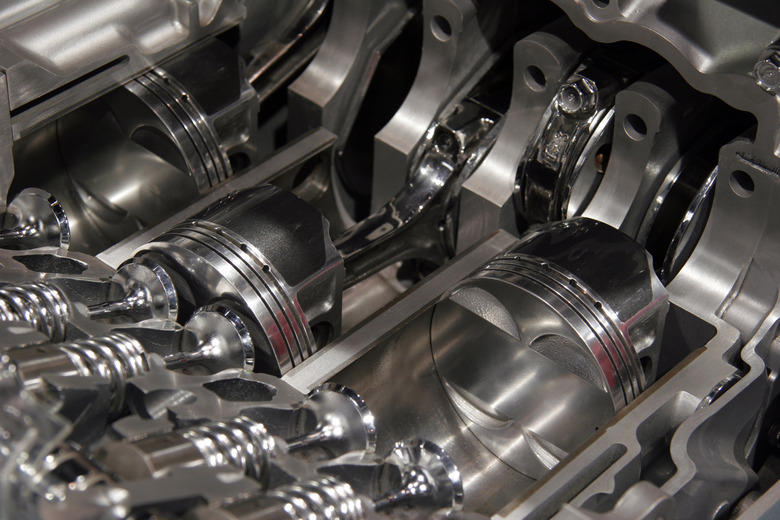How To Calculate Piston Force
A piston is the working component of engines, compressors and pumps and is housed inside a cylinder. The purpose of the piston varies depending on the system of which it is part. For example, in an engine, such as a car engine, the piston transfers force from expanding gas in the cylinder via the piston rod to the crankshaft. Calculating the force of a piston is crucial when deciding how the component will work, what practical uses it will have and how the resulting engine or compressor will function. The calculation is straightforward, provided the units remain equivalent and the correct values are input accurately.
Step 1
Measure and record the gauge pressure (p) in newtons per meter squared (N/m2). The N/m2 unit of measurement is also called the pascal (Pa). For the output stroke, the pressure will be equivalent to normal atmospheric pressure, which is standard at 100 kPa.
Step 2
Measure the full bore piston diameter (d) in meters (m) using a measuring tape or ruler, depending on the size of your piston bore setup, and record the result.
Step 3
Use the full bore piston diameter to calculate the full bore area (A) in meters squared (m2) by substituting the value you obtained from your diameter measurement into the equation A = π d2/4. π, or pi, is a constant value used in mathematics. It denotes the ratio of any circle's circumference to its diameter in space and is always equal to approximately 3.142. So, when calculating your piston area, use this value as the value of π in the equation. To do this, take the measurement of your piston diameter and square it using a calculator. A working example would be a diameter of 2.5 meters. This gives a diameter squared of 6.25 square meters; there is a button on all graphical calculators which has x2 written on it. Type your diameter into the calculator, then use this button to find the squared value. Divide the resulting value by 4. In our example, it is 6.25, so the result in our case is 1.563. Multiply this by the value of π, 3.142, and the answer is 4.909 m2. This is the bore area (A).
Step 4
Record the resulting area of your piston setup.
Step 5
Input the values obtained from each of these measurements and calculations into the main equation F = pA, where F is the piston force (F) in newtons (N), p is the gauge pressure and A is the full bore area. So, in our example, a single acting cylinder at atmospheric pressure, working on the output stroke, would require the following calculation to ascertain piston force (F): 100,000 multiplied by 4.909, which equals 490900 N.
Things Needed
- Measurement tape or ruler
- Calculator, preferably graphical
TL;DR (Too Long; Didn't Read)
Use the equations correctly to ensure you get an accurate answer to your piston force calculation. For example, in the F = pA equation, you must remember to multiply the value of p by the value of A. They are not added, divided or subtracted. Instead, the p and A are situated side by side in the equation, which means they are multiplied together. However, in the preliminary calculation of full bore diameter, found by applying the equation A = πd2/4, there are several different processes to achieving an answer which must be carried out in the correct order: d is squared first, the value of d2 is then divided by 4 and the resulting value is then multiplied by 3.142.
Warning
Take care with units. Although the 100 kPa is a more manageable value, you must expand it to the full 100,000 pascals for the purposes of the calculation. After the results have been obtained, you can then reconvert it to a smaller value if you wish, by dividing it by 1,000. The unit rule also applies to the area. Some people work in meters, some in centimeters and some in millimeters. Provided you maintain the same choice throughout the calculation, the result will be accurate and scalable, but if you use different units in different parts of the same calculation, you will get the wrong answer by several factors, meaning extra or fewer zeros than you ought to have.
Cite This Article
MLA
Parks, Natasha. "How To Calculate Piston Force" sciencing.com, https://www.sciencing.com/calculate-piston-force-7476402/. 13 March 2018.
APA
Parks, Natasha. (2018, March 13). How To Calculate Piston Force. sciencing.com. Retrieved from https://www.sciencing.com/calculate-piston-force-7476402/
Chicago
Parks, Natasha. How To Calculate Piston Force last modified August 30, 2022. https://www.sciencing.com/calculate-piston-force-7476402/
